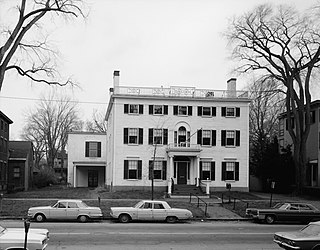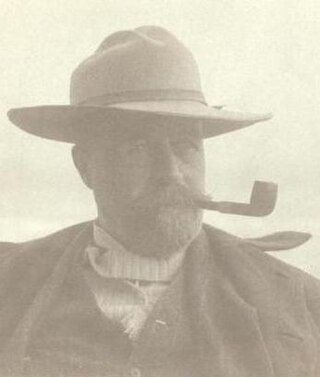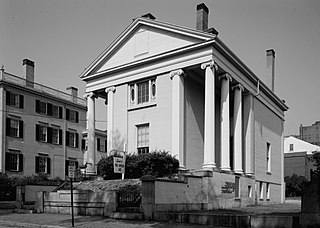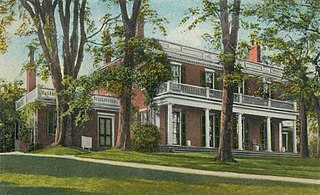
The Portland Club is a social club at 156 State Street in Portland, Maine.

Haystack Mountain School of Crafts, commonly called "Haystack," is a craft school located at 89 Haystack School Drive on the coast of Deer Isle, Maine.

John Calvin Stevens was an American architect who worked in the Shingle Style, in which he was a major innovator, and the Colonial Revival style. He designed more than 1,000 buildings in the state of Maine.

Pennellville Historic District is a residential district located in Brunswick, Maine. To locals, the neighborhood is known simply as "Pennellville."

The Ladd Carriage House is a building in downtown Portland, Oregon, at Broadway and Columbia. It is one of the few surviving buildings forming part of the former grand estates which once stood in the downtown core. It is listed on the National Register of Historic Places.
This is an incomplete list of historic properties and districts at United States colleges and universities that are listed on the National Register of Historic Places (NRHP). This includes National Historic Landmarks (NHLs) and other National Register of Historic Places listings. It includes listings at current and former educational institutions.

The McLellan-Sweat Mansion is a historic house museum on High Street in Portland, Maine. It forms the rear component of the Portland Museum of Art complex. Built in 1800–01, the house was designated a National Historic Landmark in 1970 as a well-preserved Federal style brick townhouse.

The History of Portland, Maine begins when Native Americans originally called the Portland peninsula Məkíhkanək meaning “At the fish hook” in Penobscot and Machigonne in Algonquian. The peninsula and surrounding areas was home to members of the Algonquian-speaking Aucocisco branch of the Eastern Abenaki tribe who were forcibly relocated to current day Canada during European settlement.

Westbrook College was a liberal arts college in Portland, Maine, founded 1831 as Westbrook Seminary in Westbrook, Maine. It closed in 1996 and merged with the University of New England, which uses its old campus.
The Harbor Lane–Eden Street Historic District encompasses a neighborhood of Bar Harbor, Maine, consisting of architect-designed summer estates that served as the summer of elite society families of the late 19th and early 20th centuries. Located northwest of the main village and fronting on Frenchman Bay, the district includes nine summer houses that survived a devastating 1947 fire which destroyed many other summer estates. The district was listed on the National Register of Historic Places in 2009.

The Charles Q. Clapp House is a historic house at 97 Spring Street in central Portland, Maine. Built in 1832, it is one of Maine's important early examples of high style Greek Revival architecture. Probably designed by its first owner, Charles Q. Clapp, it served for much of the 20th century as the home of the Portland School of Fine and Applied Art, now the Maine College of Art. It is now owned by the adjacent Portland Museum of Art. It was listed on the National Register of Historic Places in 1972.
Portland, Maine, is home to many neighborhoods.

Mapleton, also known as St. Joseph House, is a historic building located at White Plains, Westchester County, New York. It was added to the National Register of Historic Places in 1976.

The Spring Street Historic District encompasses surviving elements of the 19th-century commercial and surviving residential areas of Portland, Maine. Encompassing a portion of the city's Arts District and an eastern portion of its West End, the district has a significant concentration of residential and commercial buildings that survived the city's devastating 1866 fire. The district was listed on the National Register of Historic Places in 1970.

The Westbrook College Historic District is a historic district in the Deering neighborhood of Portland, Maine. It is centered on the campus of the former Westbrook College, founded in 1831 as the nation's first coeducational boarding school. The college merged with the University of New England in 1996. The district, which includes six buildings constructed between 1833 and 1952, was added to the National Register of Historic Places in 1977.

Woodlawn, also known locally as the Black House, is a 180-acre (73 ha) historic estate located a quarter mile from downtown Ellsworth, Maine, at 19 Black House Drive. The Black House Museum is open to the public seasonally and the grounds are open every day, dawn to dusk. The museum was home to three generations of the Black family and features many of their possessions. The family patriarch, John Black, was an agent for a major landowner in the region, and built the mansion house in 1824–27. There are over two miles of hiking trails, a nationally sanctioned croquet court, gardens, fields, and forest open to the public all year. The Black House Museum was listed on the National Register of Historic Places in 1969.

The Page Farm & Home Museum is a museum on the campus of the University of Maine in Orono, Maine. Its mission is "to collect, document, preserve, interpret and disseminate knowledge of Maine history relating to farms and farming communities between 1865 and 1940, providing an educational and cultural experience for the public and a resource for researchers of this period." The University of Maine was founded in 1865 as the "Maine College of Agriculture and the Mechanic Arts". The centerpiece of the museum is the Maine Experiment Station Barn, a 19th-century barn, listed on the National Register of Historic Places, that is the last standing agricultural building on the campus.

The Norton House Historic District encompasses two properties that formerly constituted the central portion of a suburban country estate in Falmouth, Maine. Located on Foreside Road, overlooking Casco Bay, the landscaped properties include a house and former carriage house designed by John Calvin Stevens and John Howard Stevens in 1912. The district was listed on the National Register of Historic Places in 2004.

The Hyde Mansion, originally known as Elmhurst, is a historic house at 616 High Street in Bath, Maine, United States. Now the main building on the Bath campus of The Hyde Schools, it was built in 1913 for John Sedgewick Hyde, the son of Bath Iron Works (BIW) founder Thomas W. Hyde. It was designed by John Calvin Stevens, and is an example of Colonial Revival architecture. It was listed on the National Register of Historic Places in 1978.

High Street is a downtown street in Portland, Maine, United States. It runs one-way for around 0.81 miles (1.30 km), from Commercial Street in the southeast to Forest Avenue in the northwest. It is one of the three main routes crossing the Portland peninsula in this direction, the other two being State Street and Franklin Street. Part of the street passes through the Spring Street Historic District and the city's Arts District.


















